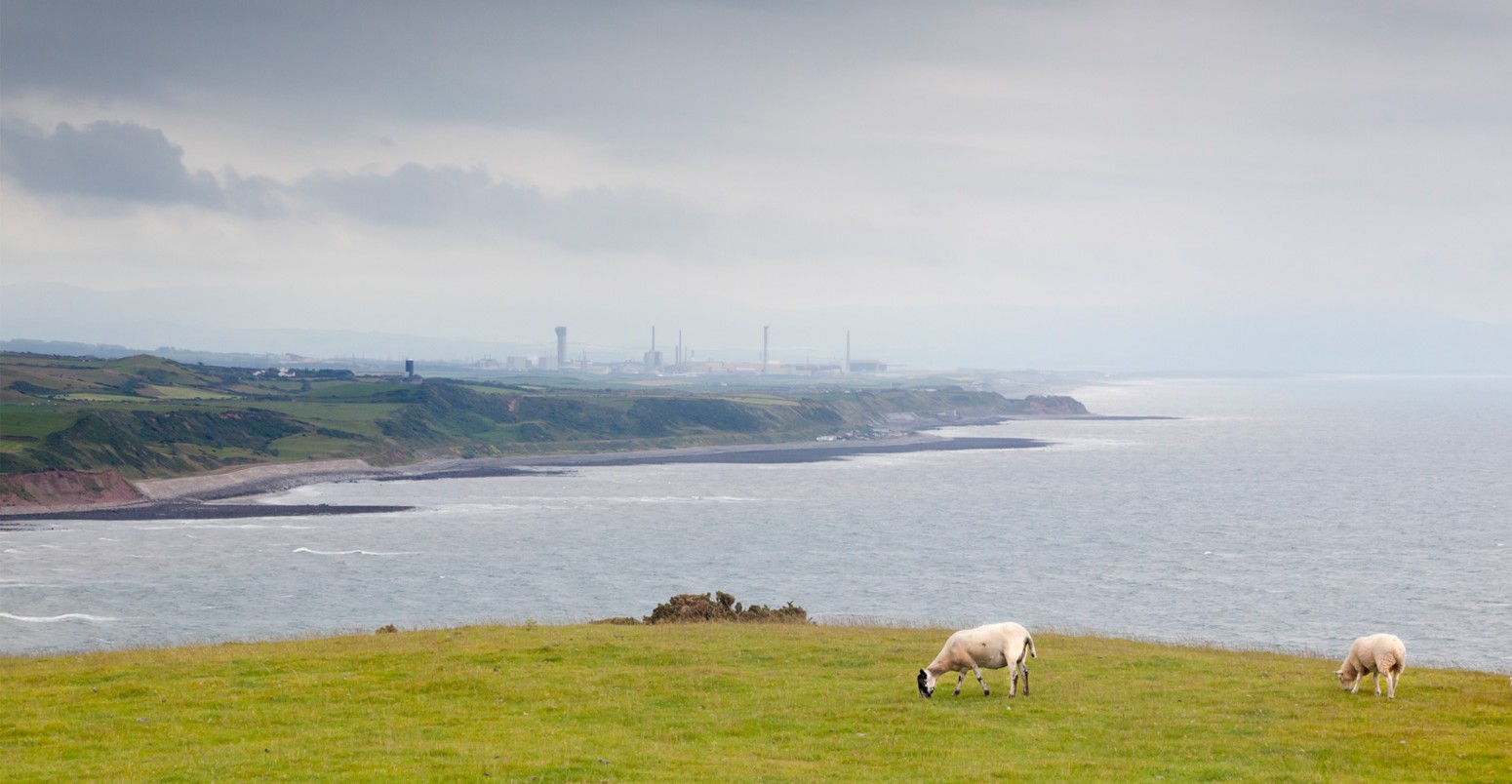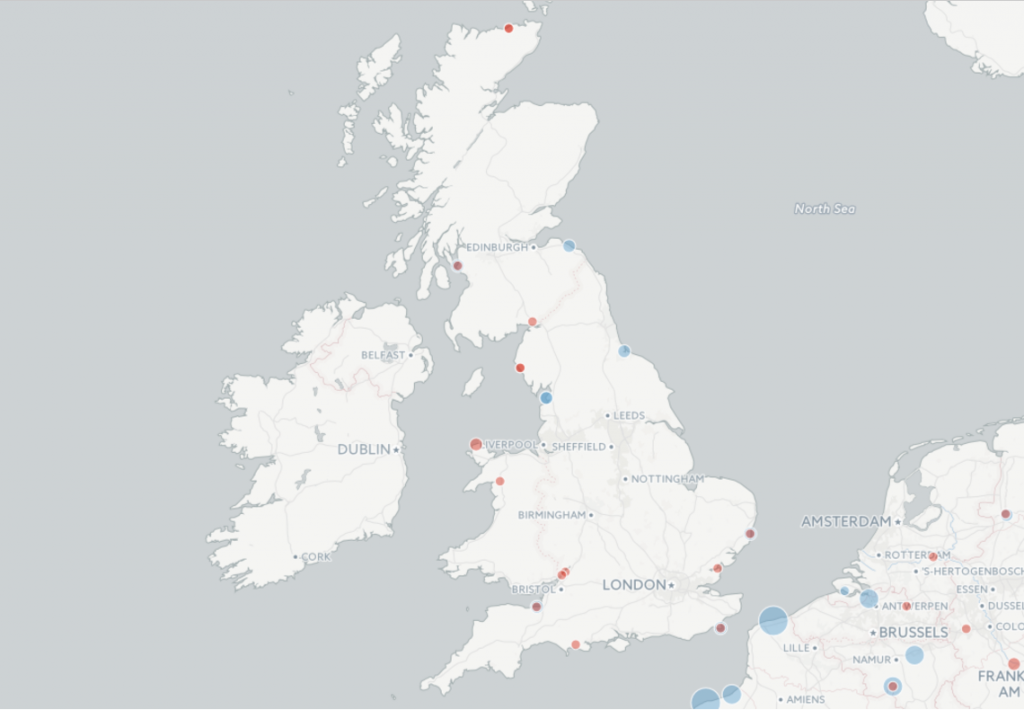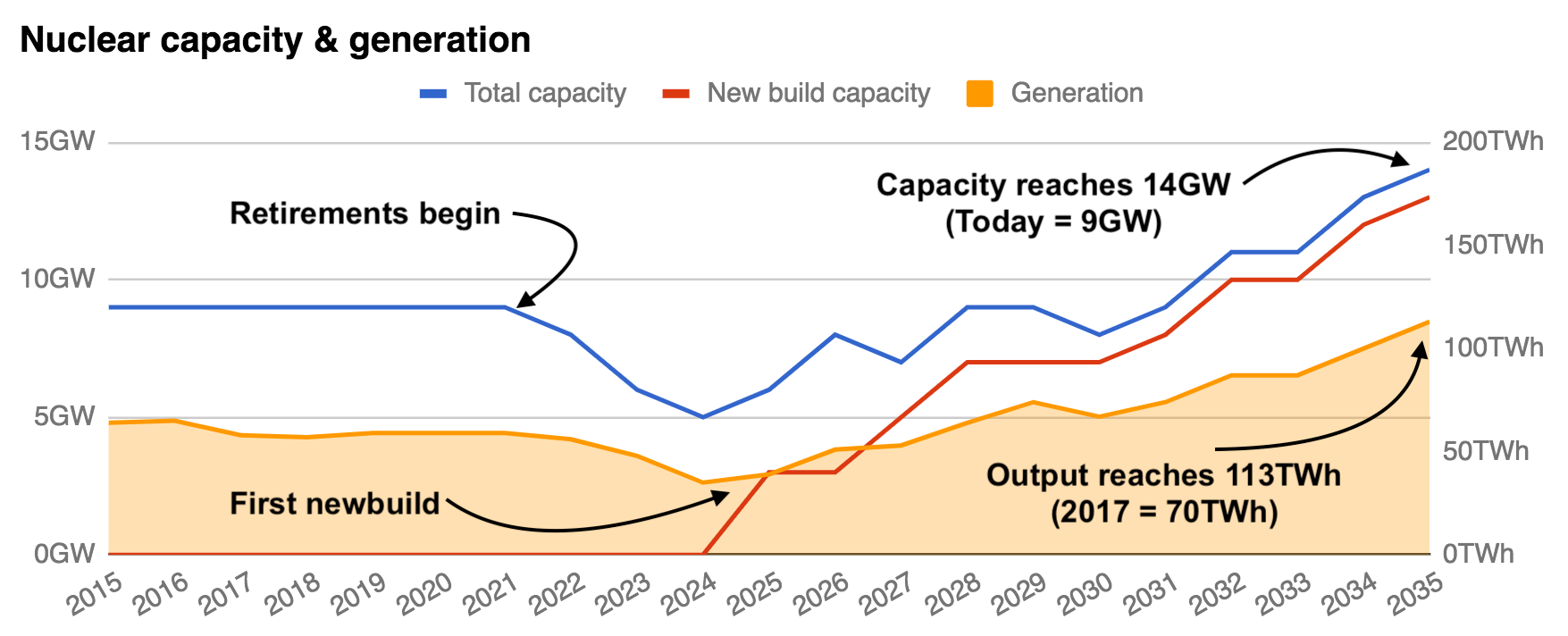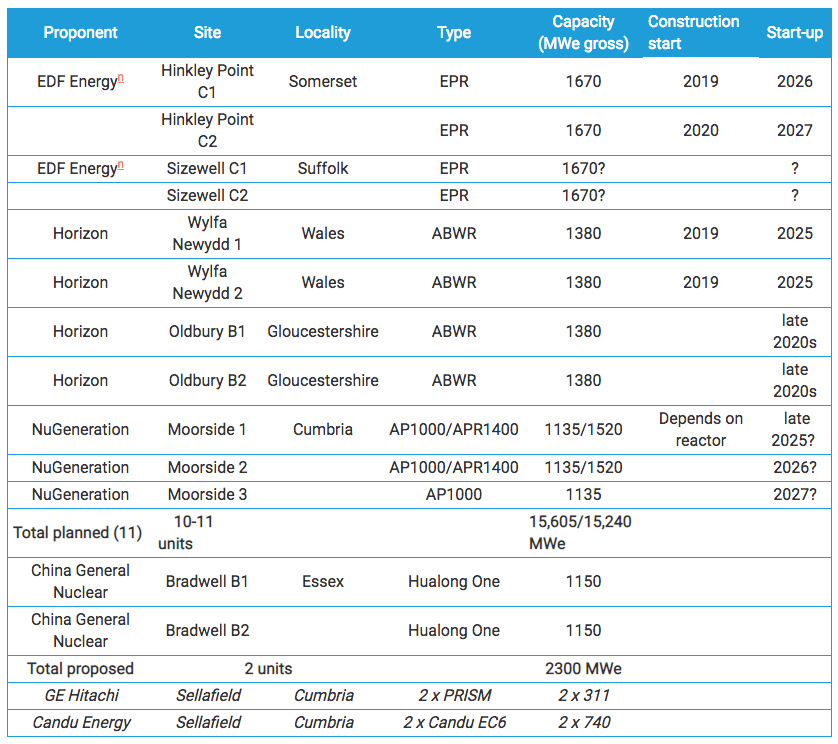
Analysis: How important was Moorside new nuclear plant to UK climate plans?
Simon Evans
02.15.17Simon Evans
15.02.2017 | 6:03pmUpdate 8/11/18: Toshiba is to wind up its NuGen subsidiary in January 2019, it has announced, leaving the planned 3.3 gigawatt (GW) Moorside new nuclear plant “abandoned“, according to the Times and others. The decision comes after Toshiba was unsuccessful in its attempts to sell the firm over the past 18 months. Toshiba shares jumped 13% on the announcement, according to BBC News.
The decision means Moorside will not get built unless a new buyer can be found. The Financial Times quotes “one senior government figure” saying there are still hopes the scheme can be salvaged but that he is “not optimistic”. Apart from the chart on nuclear generation and capacity, the article below has not been changed since it was written in February 2017. Note that government projections for nuclear generation and new build in the 2020s and 2030s have been revised downwards since then.
Note that analysis published by the Committee on Climate Change in July 2018 suggests the UK can meet its 2030 climate goals without any new nuclear plants beyond Hinkley C.
The UK’s plans for a fleet of new nuclear plants have suffered another setback after Japanese firm Toshiba said this week it would not build the planned Moorside nuclear plant in Cumbria.
Moorside is supposed to be one of six new nuclear schemes built around the UK. These form the backbone of government plans to renew and decarbonise the UK’s electricity system.
Carbon Brief has a summary of the plans and how they fit into the UK’s climate and energy future.
Nuclear power
The UK currently has eight active nuclear power stations, all operated by French firm EDF. These sites are marked in blue on the map below, or follow this link to the interactive version (note that some sites have active sites obscured by red plants that have closed down).

These active plants have a combined capacity of 8.9 gigawatts (GW). Last year, they generated 72 terawatt hours (TWh) of electricity, around a fifth of the UK total and their highest output since 2006. The UK remains one of the world’s top ten producers of nuclear power.
However, UK nuclear generation is down by more than a quarter since a 1998 peak. Since then, some 4GW of capacity at eight sites has shut down. The UK’s remaining nuclear plants are also getting old; all of them are expected to close by 2035, with only Sizewell B lasting beyond 2030.
Meanwhile, the UK plans to cut emissions to 57% below 1990 levels by 2030 and to close all coal plants by 2025. That’s where new nuclear plants are supposed to come in.
New nuclear
Update 8/11/18: The following section and chart have been brought up to date.
The most recent government projections, published in 2017, suggest new nuclear power will play a growing role in the UK’s electricity mix. The UK’s nuclear capacity will begin to fall in the early 2020s, with the 1GW Hunterston B and 1GW Hinkley Point B closing in 2023 (see chart, below).

At the time the projections were made, these closures were supposed to be followed by the opening in 2025 of Hinkley Point C, a 3.2GW plant due to be built by EDF. After long delays, a final decision to go ahead with Hinkley C was taken in 2016. Its two reactors are to open in 2026 and 2027.
Hinkley C would more than offset the loss of the 1.2GW plants at Heysham 1 and Hartlepool, due to close in 2024. The 1GW Dungeness B would close in 2028 and the 1.2GW Heysham 2 and Torness plants in 2030.
Into this breach, according to the BEIS projections, would step another five new nuclear plants, more than cancelling out the closures and bringing total UK capacity to 14GW by 2035. The table below, from the World Nuclear Association, has the details.

Carbon budgets
The UK has legally-binding carbon budgets that mean it must cut emissions to 57% below 1990 levels by 2030. Actual emissions from the power sector are not counted in this total. Instead, they are covered by the UK’s allowance under the EU Emissions Trading System (EU ETS).
If the UK were to leave the EU ETS – a prospect now being seriously considered – then power sector emissions might start counting directly against the UK’s carbon budget. This would complicate efforts to meet the emissions reduction goals.
In any case, new nuclear schemes would be expected to generate significant quantities of near-zero carbon electricity. For example, Hinkley C should generate around 25TWh of electricity, equivalent to roughly 7% of current UK demand. Similarly, Moorside would generate around 28TWh each year – some 8% of demand.
If either scheme fails to go ahead and the electricity is replaced by gas-fired power stations, it would add roughly 10 million tonnes of CO2 to the UK’s annual emissions (20MtCO2 for both).
If the 14GW of projected new nuclear plants were replaced with gas, it would add 42MtCO2, equivalent, or more than 8% of current UK greenhouse gas emissions (497MtCO2 in 2015). For the UK’s fifth carbon budget in 2028-32, UK emissions must fall to an average 353MtCO2 per year.
Alternatively, each 1GW of nuclear could be replaced with 2GW of offshore windfarm capacity or 3.2GW onshore, because windfarms have lower load factors than nuclear or gas-fired power stations.
To replace all 14GW of planned new nuclear would therefore require 28GW of offshore wind or 45GW onshore, compared to current capacities of 5.1GW and 9.4GW respectively. These figures are far beyond current plans and could even push the limits of what is technically possible for the UK.
See this earlier Carbon Brief article for some important details about these figures and discussion of the costs of intermittent generation, as well as a longer explanation of the accounting rules currently used for carbon budgets.
Nuclear progress
Of the planned new nuclear schemes, Hinkley Point C is the most advanced, having secured government approval and a final investment decision from EDF last year.
In November, a second stage of public consultation opened on EDF’s plans to build another new plant at Sizewell C. In January, it signed agreements with China General Nuclear on financing for the scheme. However, doubts hang over EDF’s financial position.
Next in line was supposed to be the Moorside scheme. However, Toshiba’s financial problems have cast a shadow over the project. It was to be built by NuGeneration (NuGen), a 60:40 joint venture between Toshiba and French firm Engie.
While Toshiba theoretically remains committed, it has said it will not take part in construction. It also owns Westinghouse, which was due to supply the reactors. Meanwhile, Engie is rumoured to want to withdraw from the consortium.
Horizon, a wholly owned subsidiary of Japanese firm Hitachi, is due to build two 2.8GW plants at Wylfa on Anglesey and Oldbury in Gloucestershire. Horizon is expected to apply for planning consent for Wylfa later this year and the plant is nominally due to open in 2025.
Finally, China General Nuclear hopes to build and operate a plant at Bradwell in Essex. In January, the government asked the Office for Nuclear Regulation to start safety-checking the firm’s Hualong One design.
For more on the history of EDF’s recent new nuclear schemes, check out this Carbon Brief article. For an in-depth look at the reasons why many new nuclear schemes have been delayed and over budget, Environmental Progress has some useful analysis.
Conclusion
The government has significant hopes for new nuclear to help renew and decarbonise the UK’s electricity system. The schemes – and the companies behind them – continue to face delays and financial problems.
This poses problems for the security of UK electricity supplies, given plans to phase out coal and limit new subsidies for renewables. If the UK leaves the EU Emissions Trading System (EUETS), then it could also pose a major challenge to meeting the UK’s carbon targets.
-
Analysis: How important is Moorside new nuclear plant to UK climate plans?

